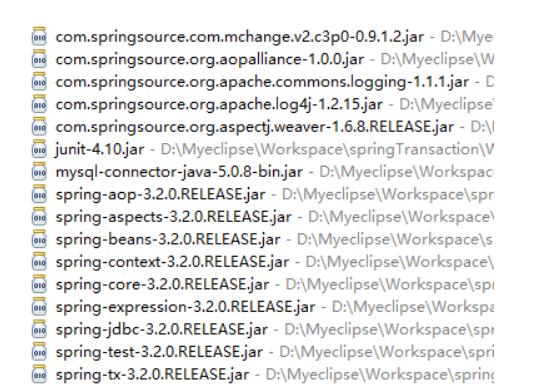实现spring事务的四种方式
Posted Bertha然
tags:
篇首语:本文由小常识网(cha138.com)小编为大家整理,主要介绍了实现spring事务的四种方式相关的知识,希望对你有一定的参考价值。
用一个银行账号转钱的案例来说明spring事务的实现。
在转钱过程中,一个账号钱增加,另一个减少,那么当有异常产生时,就会出现钱转丢了的现象
一个减少了,而另一个没有增加,这个时候就需要把这两个行为绑定到一起,要么同时发生,要么都不发生
这就用到了事务,事务就是指在逻辑上的一组操作,这组操作要么全部成功,要么全部失败
在转钱过程中,一个账号钱增加,另一个减少,那么当有异常产生时,就会出现钱转丢了的现象
一个减少了,而另一个没有增加,这个时候就需要把这两个行为绑定到一起,要么同时发生,要么都不发生
这就用到了事务,事务就是指在逻辑上的一组操作,这组操作要么全部成功,要么全部失败
实现spring事务的四种方式分别为:
(1)编程式事务管理:需要手动编写代码,在实际开发中很少使用
(2)声明式事务管理:
(2.1)基于TransactionProxyFactoryBean的方式,需要为每个进行事务管理的类做相应配置
(2.2)基于AspectJ的XML方式,不需要改动类,在XML文件中配置好即可
(2.3)基于注解的方式,配置简单,需要在业务层类中添加注解
(1)编程式事务管理:需要手动编写代码,在实际开发中很少使用
(2)声明式事务管理:
(2.1)基于TransactionProxyFactoryBean的方式,需要为每个进行事务管理的类做相应配置
(2.2)基于AspectJ的XML方式,不需要改动类,在XML文件中配置好即可
(2.3)基于注解的方式,配置简单,需要在业务层类中添加注解
(2.2)和(2.3)在开发中使用比较多,前者配置一目了然,可以在XML文件中得到所有信息,后者配置简单方便
需要做的一些准备工作:
1.在数据库中新建一张account数据表
SQL脚本:
CREATE TABLE `account` ( `id` int(11) NOT NULL AUTO_INCREMENT, `name` varchar(20) NOT NULL, `money` double DEFAULT NULL, PRIMARY KEY (`id`) ) ENGINE=InnoDB AUTO_INCREMENT=4 DEFAULT CHARSET=utf8; INSERT INTO `account` VALUES (\'1\', \'aaa\', \'1000\'); INSERT INTO `account` VALUES (\'2\', \'bbb\', \'1000\'); INSERT INTO `account` VALUES (\'3\', \'ccc\', \'1000\');
2.需要引入的Jar包

3.为数据库连接准备的配置文件- jdbc.properties
使用c3p0数据库连接池
jdbc.driverClass=com.mysql.jdbc.Driver
jdbc.url=jdbc\\:mysql\\://127.0.0.1\\:3306/test
jdbc.username=root
jdbc.password=
4.创建两个接口
AccountDao:数据库操作
public interface AccountDao {public void outMoney(String out,Double money);public void inMoney(String in,Double money);
}
AccountDao:数据库操作
public interface AccountDao {public void outMoney(String out,Double money);public void inMoney(String in,Double money);
}
AccountService:逻辑处理操作
public interface AccountService {/*** * @param out 转出账号* @param in 转入账号* @param money 转账金额*/public void transfer(String out,String in,Double money);
}
public interface AccountService {/*** * @param out 转出账号* @param in 转入账号* @param money 转账金额*/public void transfer(String out,String in,Double money);
}
5.创建以上两个接口的实现类
import org.springframework.jdbc.core.support.JdbcDaoSupport; public class AccountDaoImpl extends JdbcDaoSupport implements AccountDao{ public void outMoney(String out, Double money) { String sql="update account set money=money-? where name=?"; this.getJdbcTemplate().update(sql,money,out); } public void inMoney(String in, Double money) { String sql="update account set money=money+? where name=?"; this.getJdbcTemplate().update(sql,money,in); } }
public class AccountServiceImpl implements AccountService{ private AccountDao accountDao; public void setAccountDao(AccountDao accountDao) { this.accountDao = accountDao; } public void transfer(String out,String in,Double money) { accountDao.outMoney(out, money); accountDao.inMoney(in, money); } }
6.测试类(使用spring加JUnit4整合测试)
import javax.annotation.Resource; import org.junit.Test; import org.junit.runner.RunWith; import org.springframework.test.context.ContextConfiguration; import org.springframework.test.context.junit4.SpringJUnit4ClassRunner; @RunWith(SpringJUnit4ClassRunner.class) @ContextConfiguration("classpath:applicationContext.xml")//引入xml文件 public class TestDemo1 { @Resource(name="accountService")//得到bean id为accountService的对象 private AccountService accountService; @Test public void demo1(){ accountService.transfer("aaa", "bbb", 200d); } }
7.xml文件 - applicationContext.xml:
<?xml version="1.0" encoding="UTF-8"?> <beans xmlns="http://www.springframework.org/schema/beans" xmlns:xsi="http://www.w3.org/2001/XMLSchema-instance" xmlns:context="http://www.springframework.org/schema/context" xmlns:aop="http://www.springframework.org/schema/aop" xmlns:tx="http://www.springframework.org/schema/tx" xmlns:task="http://www.springframework.org/schema/task" xsi:schemaLocation="http://www.springframework.org/schema/beans http://www.springframework.org/schema/beans/spring-beans-3.1.xsd http://www.springframework.org/schema/context http://www.springframework.org/schema/context/spring-context-3.1.xsd http://www.springframework.org/schema/aop http://www.springframework.org/schema/aop/spring-aop-3.1.xsd http://www.springframework.org/schema/tx http://www.springframework.org/schema/tx/spring-tx-3.1.xsd http://www.springframework.org/schema/task http://www.springframework.org/schema/task/spring-task-3.1.xsd"> <!-- 引入外部的配置文件 --> <context:property-placeholder location="classpath:jdbc.properties"/> <!-- 配置c3p0连接池 --> <bean id="dataSource" class="com.mchange.v2.c3p0.ComboPooledDataSource"> <property name="driverClass" value="${jdbc.driverClass}"/> <property name="jdbcUrl" value="${jdbc.url}"/> <property name="user" value="${jdbc.username}"/> <property name="password" value="${jdbc.password}"/> </bean> <bean id="accountService" class="demo1.AccountServiceImpl"> <property name="accountDao" ref="accountDao"/> </bean> <bean id="accountDao" class="demo1.AccountDaoImpl"> <property name="dataSource" ref="dataSource"/> </bean> </beans>
代码实现方式:
(1)编程式事务管理
ServiceImpl类:
import org.springframework.transaction.TransactionStatus; import org.springframework.transaction.support.TransactionCallbackWithoutResult; import org.springframework.transaction.support.TransactionTemplate; public class AccountServiceImpl implements AccountService{ private AccountDao accountDao; public void setAccountDao(AccountDao accountDao) { this.accountDao = accountDao; } /** * 注入事务管理的模板 * 在xml文件中添加Property * <property name="transactionTemplate" ref="transactionTemplate"/> */ private TransactionTemplate transactionTemplate; public void setTransactionTemplate(TransactionTemplate transactionTemplate) { this.transactionTemplate = transactionTemplate; } public void transfer(final String out,final String in,final Double money) { /** * 在这里面进行事务操作 * 因为需要在匿名内部类中使用参数,所以给参数加上final关键字 */ transactionTemplate.execute(new TransactionCallbackWithoutResult(){ @Override protected void doInTransactionWithoutResult( TransactionStatus transactionStatus) { accountDao.outMoney(out, money); accountDao.inMoney(in, money); } }); } }
xml文件中需要配置事务管理器,无论使用哪一种方式,都需要在xml文件中配置事务管理器,将事务管理器注入到模板中,而该模板又会自动注入到accountService中,业务逻辑处理都放在了execute方法中。
<!--spring事务编程式 --> <!-- 配置事务管理器 --> <bean id="transactionManager" class="org.springframework.jdbc.datasource.DataSourceTransactionManager"> <property name="dataSource" ref="dataSource"/> </bean> <!-- 定义事务管理的模板 :Spring为了简化事务管理的代码而提供的类 --> <bean id="transactionTemplate" class="org.springframework.transaction.support.TransactionTemplate"> <property name="transactionManager" ref="transactionManager"/> </bean>
在DaoImpl类中,继承了JdbcDaoSupport类,可以省去jdbc复杂的代码
在XML文件配置中,注入dataSource用来获取数据库的连接
在XML文件配置中,注入dataSource用来获取数据库的连接
(2.1)基于TransactionProxyFactoryBean的方式
采用spring-aop的方式,需要用到代理模式
XML文件:
<!-- 配置事务管理器 --> <bean id="transactionManager" class="org.springframework.jdbc.datasource.DataSourceTransactionManager"> <property name="dataSource" ref="dataSource"/> </bean> <!-- 配置业务层代理: --> <bean id="accountServiceProxy" class="org.springframework.transaction.interceptor.TransactionProxyFactoryBean"> <!-- 配置目标对象 --> <property name="target" ref="accountService"/> <!-- 注入事务管理器 --> <property name="transactionManager" ref="transactionManager"/> <!-- 注入事务属性 --> <property name="transactionAttributes"> <props> <!-- 格式 ,key为方法名称 PROPAGATION:事务的传播行为 ISOLATION:事务的隔离级别 readOnly:只读 Exception:发生哪些异常,回滚事务 +Exception:发生哪些异常不回滚 --> <prop key="transfer">PROPAGATION_REQUIRED</prop> </props> </property> </bean>
在测试类中需自动注入的bean-id就不再是accountService了,而是代理类accountServiceProxy
此时代理类和被代理类实现了共同的接口,AccountService,有关代理模式请看:代理模式
@Resource(name="accountServiceProxy")
private AccountService accountService;
此时代理类和被代理类实现了共同的接口,AccountService,有关代理模式请看:代理模式
@Resource(name="accountServiceProxy")
private AccountService accountService;
(2.2)基于AspectJ的XML方式
XML文件:
<!-- 配置事务管理器 -->
<bean id="transactionManager"
class="org.springframework.jdbc.datasource.DataSourceTransactionManager">
<property name="dataSource" ref="dataSource"/>
</bean>
<!-- 配置的事务的通知 -->
<tx:advice id="txAdvice" transaction-manager="transactionManager">
<tx:attributes>
<!--
propagation:事务传播行为
isolation:事务隔离级别
read-only:只读
rollback-for:发生哪些异常回滚
no-rollback-for:发生哪些异常不回滚
timeout:有效期
-->
<tx:method name="transfer" propagation="REQUIRED"/>
</tx:attributes>
</tx:advice>
<!-- 配置切面 -->
<aop:config>
<aop:pointcut expression="execution(* demo3.AccountService.*(..))" id="pointcut1"/>
<aop:advisor advice-ref="txAdvice" pointcut-ref="pointcut1"/>
</aop:config>
(2.3)基于注解的方式,配置简单,需要在业务层类中添加注解
<!-- 配置事务管理器 -->
<bean id="transactionManager" class="org.springframework.jdbc.datasource.DataSourceTransactionManager">
<property name="dataSource" ref="dataSource"/>
</bean>
<!-- 开启注解事务 -->
<tx:annotation-driven transaction-manager="transactionManager"/>
在serviceImpl类中需要添加注解,参数和上面同理
@Transactional(propagation=Propagation.REQUIRED)
我这儿整理了比较全面的JAVA相关的面试资料,

需要领取面试资料的同学,请加群:473984645

以上是关于实现spring事务的四种方式的主要内容,如果未能解决你的问题,请参考以下文章